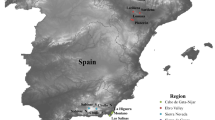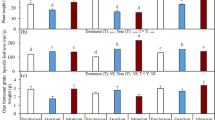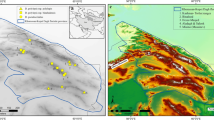Abstract
Changes in the amount and timing of precipitation may affect plant species coexistence. However, little is known about how these changes in precipitation structure plant communities. Here, we conducted a 6-year field precipitation manipulation experiment in the semi-arid steppe of Inner Mongolia, China, to assess the importance of species extinction and colonization in community assembly by incorporating information on phylogenetic and functional relatedness. Our results demonstrated that the decline in plant species richness under decreasing precipitation in the late and entire growing season could be attributed to a decrease in species colonization and an increase in species loss, respectively. The increase in species richness under increasing precipitation in the late growing season was mainly caused by increases in colonizing species. The loss of species that were more closely related to other residents under decreasing precipitation in the late growing season did not alter patterns of phylogenetic overdispersion, and the colonization of species that were more distantly related to residents under increasing precipitation in the late growing season shifted functional relatedness from clustering to randomness. Increasing precipitation may weaken the strength of environmental filtering induced by water stress in this semi-arid steppe and thus increase the probability of successful colonization of functionally dissimilar species relative to residents. Our study suggests that incorporating information on the functional and phylogenetic relatedness of locally lost resident species and the colonization of new species into analyses of community assembly processes can provide new insights into the general responses of plant communities to global change.





Similar content being viewed by others
Data availability
Data had been stored in Dryad.
References
Allan RP, Hawkins E, Bellouin N, IPCC et al (2021) Summary for policymakers. Climate change 2021: The physical science basis. Contribution of working group I to the sixth assessment report of the intergovernmental panel on climate change[R]. Cambridge University Press, Cambridge
Bin Y, Lin G, Russo SE, Huang Z, Shen Y, Cao H et al (2019) Testing the competition-colonization trade-off and its correlations with functional trait variations among subtropical tree species. Sci Rep 9:14942. https://doi.org/10.1038/s41598-019-50604-3
Blomberg SP, Garland T, Ives AR (2003) Testing for phylogenetic signal in comparative data: behavioral traits are more labile. Evolution 57:717–745. https://doi.org/10.1111/j.0014-3820.2003.tb00285.x
Cavender-Bares J, Kozak KH, Fine PVA, Kembel SW (2009) The merging of community ecology and phylogenetic biology. Ecol Lett 12:693–715. https://doi.org/10.1111/j.1461-0248.2009.01314.x
Chelli S, Canullo R, Campetella G, Schmitt AO, Bartha S, Cervellini M et al (2016) The response of sub-Mediterranean grasslands to rainfall variation is influenced by early season precipitation. Appl Veg Sci 19:611–619. https://doi.org/10.1111/avsc.12247
Denton EM, Dietrich JD, Smith MD, Knapp AK (2017) Drought timing differentially affects above- and belowground productivity in a mesic grassland. Plant Ecol 218:317–328. https://doi.org/10.1007/s11258-016-0690-x
Dong L, Liang C, Li FY, Zhao L, Tuvshintogtokh I (2019) Community phylogenetic structure of grasslands and its relationship with environmental factors on the Mongolian Plateau. J Arid Land 11:595–607. https://doi.org/10.1007/s40333-019-0122-6
Hoover DL, Knapp AK, Smith MD (2014) Contrasting sensitivities of two dominant C4 grasses to heat waves and drought. Plant Ecol 215:721–731. https://doi.org/10.1007/s11258-014-0345-8
Lavergne S, Mouquet N, Thuiller W, Ronce O (2010) Biodiversity and climate change: integrating evolutionary and ecological responses of species and communities. Annu Rev Ecol Evol S 41:321–350. https://doi.org/10.1146/annurev-ecolsys-102209-144628
Li S, Cadotte MW, Meiners SJ, Hua Z, Jiang L, Shu W (2015) Species colonisation, not competitive exclusion, drives community overdispersion over long- term succession. Ecol Lett 18:964–973. https://doi.org/10.1111/ele.12476
Li Y, Niu SL, Yu GR (2016) Aggravated phosphorus limitation on biomass production under increasing nitrogen loading: a meta-analysis. Global Change Biol 22:934–943. https://doi.org/10.1111/gcb.13125
Lin D, Xia J, Wan S (2010) Climate warming and biomass accumulation of terrestrial plants: a meta-analysis. New Phytol 188:187–198. https://doi.org/10.1111/j.1469-8137.2010.03347.x
Mariotte P, Vandenberghe C, Kardol P, Hagedorn F, Buttler A (2013) Subordinate plant species enhance community resistance against drought in semi-natural grasslands. J Ecol 101:763–773. https://doi.org/10.1111/1365-2745.12064
Menzel A, Sparks TH, Estrella N, Koch E, Aasa A, Ahas R et al (2006) European phenological response to climate change matches the warming pattern. Global Change Biol 12:1969–1976. https://doi.org/10.1053/jlts.2003.50055
Mudrák O, Janecek Š, Götzenberger L, Mason NWH, Jorník H, de Castro I et al (2016) Fine-scale coexistence patterns along a productivity gradient in wet meadows: shifts from trait convergence to divergence. Ecography 39:338–348. https://doi.org/10.1111/ecog.01723
Niu S, Wu M, Han Y, Xia J, Li L, Wan S (2008) Water-mediated responses of ecosystem C fluxes to climatic change in a temperate steppe. New Phytol 177:209–219. https://doi.org/10.1111/j.1469-8137.2007.02237.x
Peng S, Piao S, Shen Z, Ciais P, Sun Z, Chen S et al (2013) Precipitation amount, seasonality and frequency regulate carbon cycling of a semi-arid grassland ecosystem in Inner Mongolia, China: a modeling analysis. Agric for Meteorol 178:46–55. https://doi.org/10.1016/j.agrformet.2013.02.002
Pillar VD, Duarte LDS, Sosinski EE, Joner F (2009) Discriminating trait-convergence and trait-divergence assembly patterns in ecological community gradients. J Veg Sci 20:334–348. https://doi.org/10.1111/j.1654-1103.2009.05666.x
Schneider CA, Rasband WS, Eliceiri KW (2012) NIH image to imagej: 25 years of image analysis. Nat Methods 9:671–675. https://doi.org/10.1038/nmeth.2089
Smith MD, Pierre KL, Collins SL, Knapp AK, Gross KL, Barrett JE et al (2015) Global environmental change and the nature of aboveground net primary productivity responses: insights from long-term experiments. Oecologia 177(4):935–947. https://doi.org/10.1007/s00442-015-3230-9
Song B, Niu S, Wan S (2016) Precipitation regulates plant gas exchange and its long-term response to climate change in a temperate grassland. J Plant Ecol 9:531–541. https://doi.org/10.1093/jpe/rtw010
Suding KN, Collins SL, Gough L, Clark C, Cleland EE, Gross KL et al (2005) Functional and abundance-based mechanisms explain diversity loss due to N fertilization. P Natl Acad Sci US A 102:4387–4392. https://doi.org/10.1073/pnas.0408648102
Suttle KB, Thomsen MA, Power ME (2007) Species interactions reverse grassland responses to changing climate. Science 315:640–642. https://doi.org/10.1126/science.1136401
Webb CO, Ackerly DD, McPeek MA, Donoghue MJ (2002) Phylogenies and community ecology. Annu Rev Ecol S 33:475–505. https://doi.org/10.1146/annurev.ecolsys.33.010802.150448
Webb CO, Ackerly DD, Kembel SW (2008) Phylocom: software for the analysis of phylogenetic community structure and trait evolution. Bioinformatics 18:2098–2100. https://doi.org/10.1093/bioinformatics/btn358
Weiher E, Clarke GDP, Keddy PA (1998) Community assembly rules, morphological dispersion, and the coexistence of plant species. Oikos 81:309–322
Wiens JJ, Graham CH (2005) Niche conservatism: integrating evolution, ecology, and conservation biology. Annu Rev Ecol Evol S 36:519–539. https://doi.org/10.1146/annurev.ecolsys.36.102803.095431
Willis CG, Ruhfel B, Primack RB, Miller-Rushing AJ, Davis CC (2008) Phylogenetic patterns of species loss in Thoreau’s woods are driven by climate change. P Natl Acad Sci USA 105:17029–17033. https://doi.org/10.1073/pnas.0806446105
Xu ZW, Li MH, Zimmermann NE, Li SP, Li H, Ren HY et al (2018) Plant functional diversity modulates global environmental change effects on grassland productivity. J Ecol 106(5):1941–1951. https://doi.org/10.1111/1365-2745.12951
Yang H, Li Y, Wu M, Zhang Z, Li L, Wan S (2011) Plant community responses to nitrogen addition and increased precipitation: The importance of water availability and species traits. Global Change Biol 17:2936–2944. https://doi.org/10.1111/gcb.v17.9
Yang Z, Powell JR, Zhang C, Du G (2012) The effect of environmental and phylogenetic drivers on community assembly in an alpine meadow community. Ecology 93:2321–2328. https://doi.org/10.1890/11-2212.1
Yang Z, Hautier Y, Borer E, Zhang C, Du G (2015) Abundance and functional based mechanisms of plant diversity loss with fertilization in the presence and absence of herbivores. Oecologia 179:261–270. https://doi.org/10.1007/s00442-015-3313-7
Yang X, Yang Z, Tan J, Li G, Wan S, Jiang L (2017) Nitrogen fertilization, not water addition, alters plant phylogenetic community structure in a semi- arid steppe. J Ecol 106(3):991–1000. https://doi.org/10.1111/1365-2745.12893
Yang Z, Wei Y, Fu G, Xiao R, Chen J, Zhang Y et al (2021) Decreased precipitation in the late growing season weakens an ecosystem carbon sink in a semiarid grassland. J Appl Ecol 58(10):2101–2112. https://doi.org/10.1111/1365-2664.13942
Zanne A, Tank D, Cornwell W, Eastman JM, Smith SA, FitzJohn RG et al (2014) Three keys to the radiation of angiosperms into freezing environments. Nature 506:89–92. https://doi.org/10.1038/nature12872
Zavaleta ES, Shaw MR, Chiariello NR, Thomas BD, Cleland EE, Field CB et al (2003) Grassland responses to three years of elevated temperature, CO2, precipitation, and N deposition. Ecol Monogr 73:585–604. https://doi.org/10.1890/02-4053
Zhang B, Zhua J, Pana Q, Liu Y, Chen S, Chen D et al (2017) Grassland species respond differently to altered precipitation amount and pattern. Environ Exp Bot 137:166–176. https://doi.org/10.1016/j.envexpbot.2017.02.006
Zhang J, Miao Y, Zhang T, Wei Y, Qiao X, Miao R et al (2020a) Drought timing and primary productivity in a semiarid grassland. Land Degrad Dev 15(10):1002–1015. https://doi.org/10.1002/ldr.3603
Zhang J, Li J, Xiao R, Zhang J, Wang D, Miao R et al (2020b) Effect of precipitation changes on primary productivity in grasslands: a synthesis of global precipitation manipulative experiments. J Veg Sci 32(1):e12954. https://doi.org/10.1111/jvs.12954
Zhu J, Zhang Y, Yang X, Chen N, Li S, Wang P et al (2020) Warming alters plant phylogenetic and functional community structure. J Ecol 108(6):2406
Acknowledgements
We thank Jiajia Zhang, Xiaoxin Qiao, and many others for assistance in both the field and lab. This study was funded by Key project of National Natural Science Foundation of China (32130066), Natural Science Foundation of Henan Province, China (202300410082 and 222300420108), and National Natural Science Foundation of China (32201333 and 32271645).
Funding
The authors have not disclosed any funding.
Author information
Authors and Affiliations
Contributions
YZL and LGY conceived and designed the experiments. WMM and YJW performed the experiments. XR, SYF, and MC analyzed the data. YZL wrote the paper. ZT and LGY provided editorial advice.
Corresponding authors
Ethics declarations
Conflict of interest
The authors declare that they have no conflict of interests.
Additional information
Communicated by Douglas A Frank.
Supplementary Information
Below is the link to the electronic supplementary material.
Rights and permissions
Springer Nature or its licensor (e.g. a society or other partner) holds exclusive rights to this article under a publishing agreement with the author(s) or other rightsholder(s); author self-archiving of the accepted manuscript version of this article is solely governed by the terms of such publishing agreement and applicable law.
About this article
Cite this article
Yang, Z., Wang, M., Yang, J. et al. The effect of precipitation timing on phylogenetic and functional community structure in a semi-arid steppe. Oecologia 201, 173–182 (2023). https://doi.org/10.1007/s00442-022-05298-2
Received:
Accepted:
Published:
Issue Date:
DOI: https://doi.org/10.1007/s00442-022-05298-2




